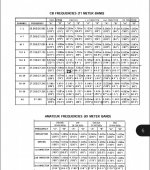Humblehero666
Member
- Joined
- Oct 28, 2020
- Messages
- 35
I have a MACO M105C as I mentioned here. I have 5 Elements with a 26' beam. It's constructed out of aluminum. I have a fifty foot piece of coax going into the radio.
The question is how can I get 28.35 10 meters?
The instructions only give different options so I'm trying to tune it to this frequency.
I have using a LDG Z PLUS to tune.
I am using a ASTATIC PDC1 swr meter.
Iam Using a yaesu ft840 with a yaesu md-1 mic.
Any help is appreciated. I just got my license not to long ago. I have been studying for a general and plan on ordering a book on structure of antennas.
Thanks in advance '73 from KC1PNR!!!
The question is how can I get 28.35 10 meters?
The instructions only give different options so I'm trying to tune it to this frequency.
I have using a LDG Z PLUS to tune.
I am using a ASTATIC PDC1 swr meter.
Iam Using a yaesu ft840 with a yaesu md-1 mic.
Any help is appreciated. I just got my license not to long ago. I have been studying for a general and plan on ordering a book on structure of antennas.
Thanks in advance '73 from KC1PNR!!!



